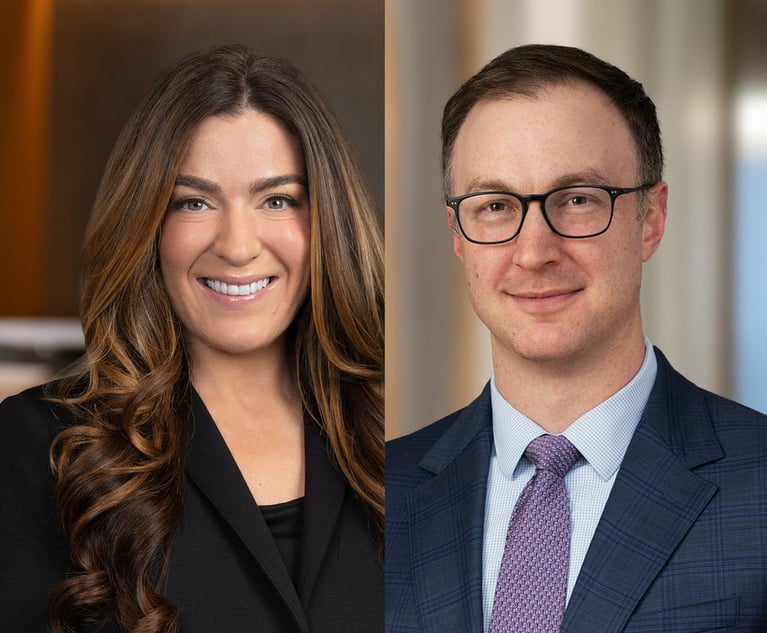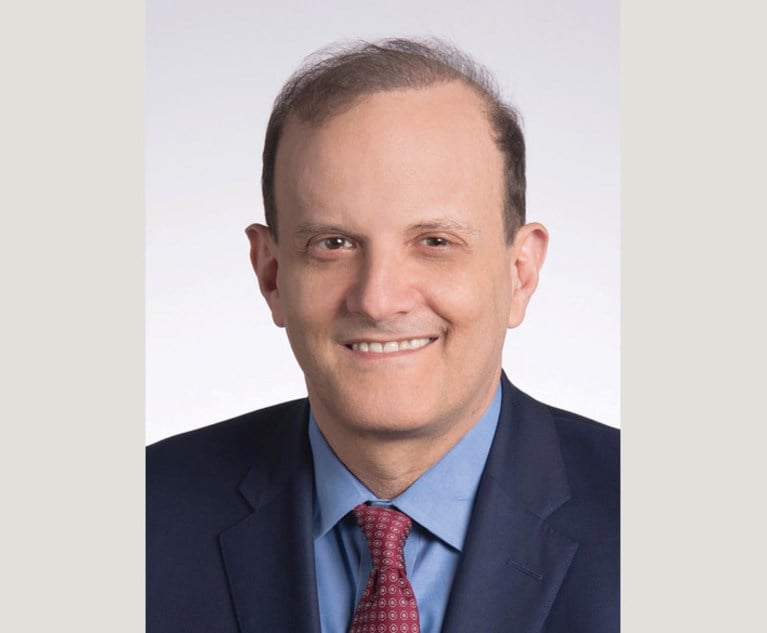 Brian D. Lipkin, Babst Calland
Brian D. Lipkin, Babst CallandWhat to Expect When You're Expecting OSHA to Visit Your Reopened Workplace
On May 19, OSHA issued two enforcement memos outlining its plans to inspect workplaces during the COVID-19 pandemic. These memos took effect on May 26.
June 04, 2020 at 12:49 PM
4 minute read
The Occupational Safety and Health Administration (OSHA) is the federal agency that enforces workplace safety and health rules. On May 19, OSHA issued two enforcement memos outlining its plans to inspect workplaces during the COVID-19 pandemic. These memos took effect on May 26.
As workplaces reopen, here is what employers can expect:
- High Exposure Workplace Inspections
When employees go back to work, OSHA anticipates an influx of COVID-19-related complaints. As a result, OSHA will prioritize inspections of workplaces with "high" and "very high" risks of COVID-19 exposure, including medical facilities, nursing homes and clinical laboratories.
OSHA is less likely to visit workplaces with medium- and low-risk levels, meaning that employees have less frequent and less close contact with the public. So, retail stores and offices are unlikely to have an OSHA compliance officer pay a visit. If OSHA receives a complaint about a medium- or low-risk workplace, it will typically send a letter, ask the employer to respond in writing and close the inspection without any in-person contact.
- Allowances for Unavailable Equipment
OSHA requires all businesses to provide workers with personal protective equipment. Depending on the type of workplace, equipment to protect against COVID-19 can include masks, gloves and hand sanitizer.
Having shopped at Target recently, OSHA compliance officers understand many businesses can't purchase these items because they are in limited supply. OSHA will use its discretion in citing employers that have acted in good faith, so employers should document their attempts to purchase any equipment that is unavailable.
If a business can't purchase the right protective equipment, it should consider changing workplace rules to limit exposure risks. For example, capacity controls or schedule changes could limit the number of people who come close into close contact with each other.
Next, the enforcement memos suggest that businesses should consider the pros and cons of using any expired equipment they may have. As a last resort, businesses can consider improvising with the protective equipment they are able to obtain.
- Recordkeeping Requirements
As part of an inspection, OSHA is likely to ask employers for written records. For example, OSHA requires all employers to conduct a "hazard assessment," which involves deciding whether the workplace presents risks which require employees to use personal protective equipment. OSHA also requires employers to document in writing that they have done this assessment. Employers may need to update hazard assessments to take into account COVID-19 risks, and should document any changes.
Employers should also be prepared to share with OSHA any policies and training materials relating to COVID-19. When employers provide training, it is a best practice to create a sign-in sheet documenting the name and date of each employee's session.
Finally, OSHA requires certain employers to keep an OSHA 300 Log listing work-related injuries and illnesses. (Employers with 10 or fewer employees, and employers in certain low-risk industries, are exempt from this requirement.) In deciding whether an illness is work-related, the employer must consider whether an exposure in the workplace caused or contributed to the condition. While this standard might seem straightforward, it can be difficult or impossible to identify how an employee contracts COVID-19, leading employers to be uncertain about how they should report these illnesses.
In its enforcement memos, OSHA clarifies that if an employee gets the COVID-19 virus, the employer does not need to "undertake extensive medical inquiries" to determine whether to report the illness on its OSHA 300 Log. Instead, the employer should use common sense to evaluate the most likely source of infection. For instance, if an employee does not have frequent contact with the general public, and was the only employee in the workplace with COVID-19, the transmission probably occurred outside of work, and likely would not need to be reported.
- Next Steps
Now is the best time for employers to prepare for a potential OSHA inspection. Based on these enforcement memos, we expect OSHA to prioritize inspections of high-risk workplaces, require employers to use good faith to obtain appropriate protective equipment, and request records showing efforts to limit COVID-19 risks.
For the latest updates on OSHA's response to COVID-19, employers can visit OSHA's website at osha.gov/covid-19.
Brian D. Lipkin is an associate with the Pittsburgh law firm of Babst Calland Clements & Zomnir. He represents employers in workplace safety and health matters. Contact him at 412-394-5456 or [email protected].
This content has been archived. It is available through our partners, LexisNexis® and Bloomberg Law.
To view this content, please continue to their sites.
Not a Lexis Subscriber?
Subscribe Now
Not a Bloomberg Law Subscriber?
Subscribe Now
NOT FOR REPRINT
© 2025 ALM Global, LLC, All Rights Reserved. Request academic re-use from www.copyright.com. All other uses, submit a request to [email protected]. For more information visit Asset & Logo Licensing.
You Might Like
View All
Chair of Montgomery McCracken Decamps for Morgan Lewis

Avoiding Conflict When Relating Advice to an Adverse Party to Facilitate a Client Matter
4 minute read
Law Firms Mentioned
Trending Stories
Who Got The Work
Michael G. Bongiorno, Andrew Scott Dulberg and Elizabeth E. Driscoll from Wilmer Cutler Pickering Hale and Dorr have stepped in to represent Symbotic Inc., an A.I.-enabled technology platform that focuses on increasing supply chain efficiency, and other defendants in a pending shareholder derivative lawsuit. The case, filed Oct. 2 in Massachusetts District Court by the Brown Law Firm on behalf of Stephen Austen, accuses certain officers and directors of misleading investors in regard to Symbotic's potential for margin growth by failing to disclose that the company was not equipped to timely deploy its systems or manage expenses through project delays. The case, assigned to U.S. District Judge Nathaniel M. Gorton, is 1:24-cv-12522, Austen v. Cohen et al.
Who Got The Work
Edmund Polubinski and Marie Killmond of Davis Polk & Wardwell have entered appearances for data platform software development company MongoDB and other defendants in a pending shareholder derivative lawsuit. The action, filed Oct. 7 in New York Southern District Court by the Brown Law Firm, accuses the company's directors and/or officers of falsely expressing confidence in the company’s restructuring of its sales incentive plan and downplaying the severity of decreases in its upfront commitments. The case is 1:24-cv-07594, Roy v. Ittycheria et al.
Who Got The Work
Amy O. Bruchs and Kurt F. Ellison of Michael Best & Friedrich have entered appearances for Epic Systems Corp. in a pending employment discrimination lawsuit. The suit was filed Sept. 7 in Wisconsin Western District Court by Levine Eisberner LLC and Siri & Glimstad on behalf of a project manager who claims that he was wrongfully terminated after applying for a religious exemption to the defendant's COVID-19 vaccine mandate. The case, assigned to U.S. Magistrate Judge Anita Marie Boor, is 3:24-cv-00630, Secker, Nathan v. Epic Systems Corporation.
Who Got The Work
David X. Sullivan, Thomas J. Finn and Gregory A. Hall from McCarter & English have entered appearances for Sunrun Installation Services in a pending civil rights lawsuit. The complaint was filed Sept. 4 in Connecticut District Court by attorney Robert M. Berke on behalf of former employee George Edward Steins, who was arrested and charged with employing an unregistered home improvement salesperson. The complaint alleges that had Sunrun informed the Connecticut Department of Consumer Protection that the plaintiff's employment had ended in 2017 and that he no longer held Sunrun's home improvement contractor license, he would not have been hit with charges, which were dismissed in May 2024. The case, assigned to U.S. District Judge Jeffrey A. Meyer, is 3:24-cv-01423, Steins v. Sunrun, Inc. et al.
Who Got The Work
Greenberg Traurig shareholder Joshua L. Raskin has entered an appearance for boohoo.com UK Ltd. in a pending patent infringement lawsuit. The suit, filed Sept. 3 in Texas Eastern District Court by Rozier Hardt McDonough on behalf of Alto Dynamics, asserts five patents related to an online shopping platform. The case, assigned to U.S. District Judge Rodney Gilstrap, is 2:24-cv-00719, Alto Dynamics, LLC v. boohoo.com UK Limited.
Featured Firms
Law Offices of Gary Martin Hays & Associates, P.C.
(470) 294-1674
Law Offices of Mark E. Salomone
(857) 444-6468
Smith & Hassler
(713) 739-1250






